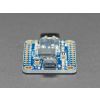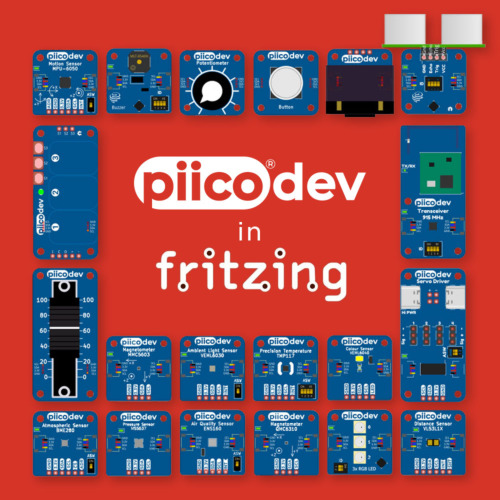Adafruit FT232H Breakout - General Purpose USB to GPIO, SPI, I2C - USB C & Stemma QT
In stock, ships same business day if ordered before 2PM
Delivered by Tue, 23rd of Dec
Quantity Discounts:
- 10+ $24.16 (exc GST)
- 50+ $23.66 (exc GST)
Wouldn't it be cool to drive a tiny OLED display, read a color sensor, or even just flash some LEDs directly from your computer? Sure you can program an Arduino or Trinket to talk to these devices and your computer, but why can't your computer just talk to those devices and sensors itself? Well, now your computer can talk to devices using the Adafruit FT232H breakout board!
What can the FT232H chip do? This chip from FTDI is similar to their USB to serial converter chips but adds a 'multi-protocol synchronous serial engine' which allows it to speak many common protocols like SPI, I2C, serial UART, JTAG, and more! There's even a handful of digital GPIO pins that you can read and write to do things like flash LEDs, read switches or buttons, and more. The FT232H breakout is like adding a little swiss army knife for serial protocols to your computer!
This chip is powerful and useful to have when you want to use Python (for example) to quickly iterate and test a device that uses I2C, SPI or plain general purpose I/O. There's no firmware to deal with, so you don't have to deal with how to "send data to and from an Arduino which is then sent to and from" an electronic sensor or display or part.
This breakout has an FT232H chip and an EEPROM for onboard configuration. You can read tons more about this chip from FTDI's page and check out Adafruit's tutorial on how to get started and use Adafruit's Python code to control the FT232H with Mac/Win/Linux and get access to Adafruit's hundreds of CircuitPython libraries and tutorials.
NEW: As of Feb 12, 2020 Adafruit have given this venerable board a makeover! Adafruit now have a modern USB C connector on the board (instead of micro USB), a I2C switch to connect D1 and D2 for easy I2C interfacing, 3V power output pin up to 500mA, and a Stemma QT connector that lets you plug & play any Stemma QT or Qwiic devices, sensors and displays. This revision is completely back-compatible for board size, mounting holes and pinouts (the additional 3V/GND pins are where previously there were none and do not change the pinout, they can be left disconnected).
Technical Details
- 23mm x 38mm x 4mm / 0.9" x 1.5" x 0.2"
- Weight: 3.4g
- EagleCAD PCB files and Fritzing object available from tutorial downloads page
Revision history:
- As of Feb 12, 2020 Adafruit have given this venerable board a makeover! Adafruit now have a modern USB C connector on the board (instead of micro USB), a I2C switch to connect D0 and D1 for easy I2C interfacing, 3V power output pin up to 500mA, and a Stemma QT connector that lets you plug & play any Stemma QT or Qwiic devices, sensors and displays. This revision is back-compatible for board size, mounting holes and pinouts (the additional 3V/GND pins are where previously there were none and do not change the pinout, they can be left disconnected).
Exact shipping can be calculated on the view cart page (no login required).
Products that weigh more than 0.5 KG may cost more than what's shown (for example, test equipment, machines, >500mL liquids, etc).
We deliver Australia-wide with these options (depends on the final destination - you can get a quote on the view cart page):
- $3+ for Stamped Mail (typically 10+ business days, not tracked, only available on selected small items)
- $7+ for Standard Post (typically 6+ business days, tracked)
- $11+ for Express Post (typically 2+ business days, tracked)
- Pickup - Free! Only available to customers who live in the Newcastle region (must order online and only pickup after we email to notify you the order is ready). Orders placed after 2PM may not be ready until the following business day.
Non-metro addresses in WA, NT, SA & TAS can take 2+ days in addition to the above information.
Some batteries (such as LiPo) can't be shipped by Air. During checkout, Express Post and International Methods will not be an option if you have that type of battery in your shopping cart.
International Orders - the following rates are for New Zealand and will vary for other countries:
- $12+ for Pack and Track (3+ days, tracked)
- $16+ for Express International (2-5 days, tracked)
If you order lots of gear, the postage amount will increase based on the weight of your order.
Our physical address (here's a PDF which includes other key business details):
40 Aruma Place
Cardiff
NSW, 2285
Australia
Take a look at our customer service page if you have other questions such as "do we do purchase orders" (yes!) or "are prices GST inclusive" (yes they are!). We're here to help - get in touch with us to talk shop.
Have a product question? We're here to help!
Guides
Three Golden Rules for Choosing a Power Supply (No Maths!)
The Maker Revolution
Prototyping a Circuit: Methods and Tools
Fritzing for Schematic and PCB Design
Projects
Pico-Dog Motion Activated Audio Alarm
WaveJumper: Music Sample Slicer on a Breadboard
PiicoDev Ecosystem In Fritzing
Makers love reviews as much as you do, please follow this link to review the products you have purchased.





















Product Comments